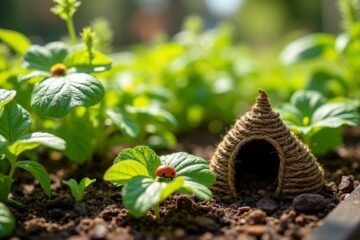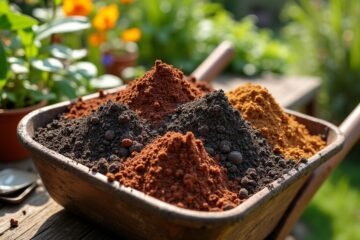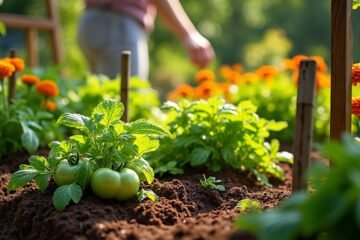Spring’s here, and your raised beds are calling! Plant crisp peas, vibrant radishes, and nutrient-packed kale to kick off your gardening adventure. These cool-weather crops thrive in spring’s hold, promising a burst of freshness in your meals. Imagine biting into tender spinach or snipping fragrant basil for a delightful salad! There’s so much more to discover, like companion planting tips and pest management strategies, to guarantee your garden flourishes all season long!
Spring Vegetables to Consider
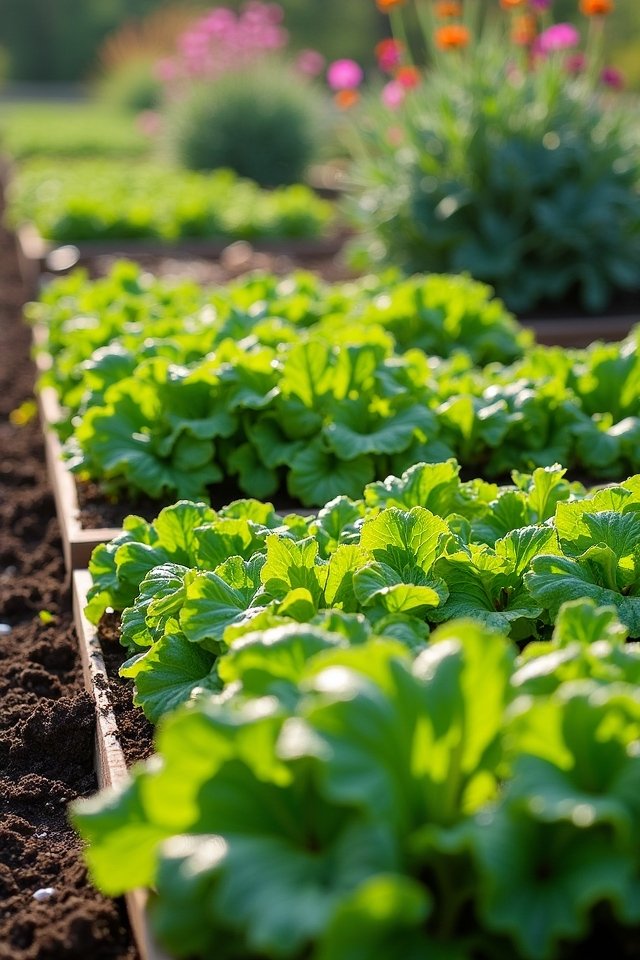
Spring’s arrival brings a burst of life and color, making it the perfect time to dig into your garden! As the cool weather lingers in early spring, consider planting delicious peas, crisp radishes, or vibrant spinach. These snap-worthy veggies thrive in the brisk temperatures, offering a delightful crunch to your salads! Speaking of crunch, why not add some carrots to the mix? They love the cool soil and can grow magic beneath the surface. And let’s not forget kale, the superstar of superfoods, which shines bright and green during these chilly months. So, roll up your sleeves, grab your seeds, and get ready for a garden filled with fresh, healthy choices! Who knew spring could taste so good?
Summer Crop Recommendations
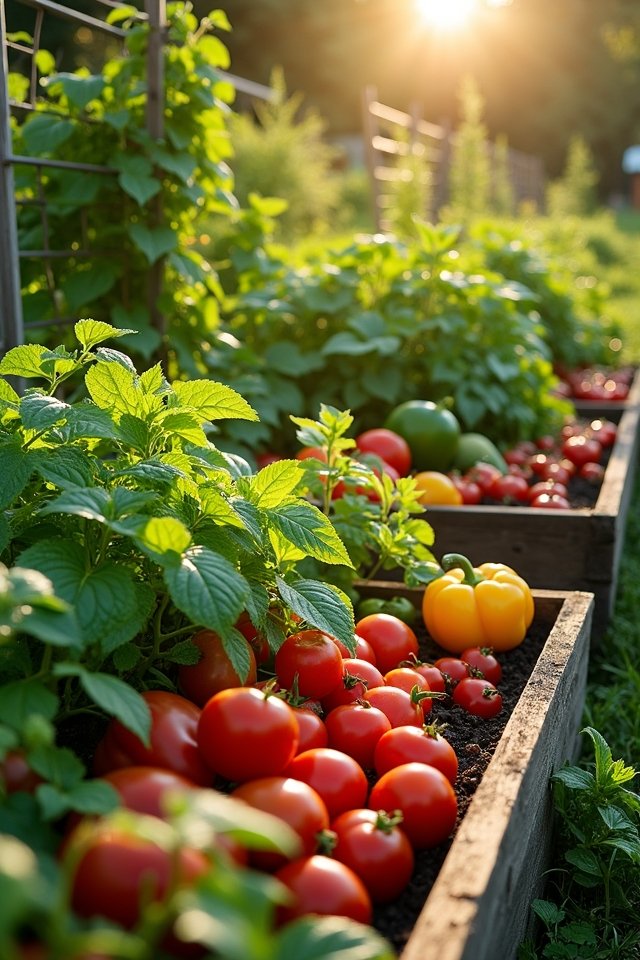
When summer rolls around, your garden transforms from a cozy spring retreat into a vibrant feast of colors and flavors! You’ll want to explore diverse tomato varieties, like the sweet heirloom Brandywine or the tangy Sun Gold. They’ll burst with flavor and liven up your meals! Don’t forget about squash options; zucchini’s your go-to for easy growth, while pattypan adds whimsical flair to your plate. Picture golden, sun-kissed squash sautéed with garlic and olive oil—yum! Plus, planting basil alongside your tomatoes creates a heavenly aroma and enhances their taste. Spicing things up feels right! So, get out there, dig in, and watch your raised bed come to life this summer; it’s an adventure in every bite!
Fall Planting Choices
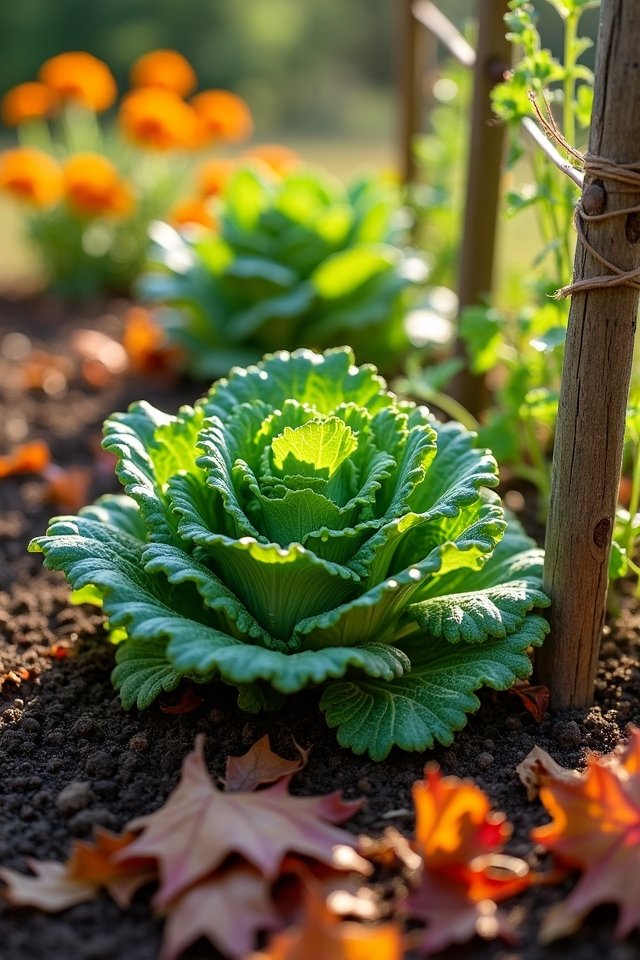
As the days start to cool off and autumn whispers its arrival, your raised bed transforms into a canvas of stunning fall colors and flavors! Imagine rich orange pumpkins, vibrant greens of kale, and the alluring purples of beets staring back at you! These fall crops not only offer a feast for the eyes but also pack a nutritious punch for your meals. Want to welcome innovation? Try growing unique varieties like purple carrots or flat-leafed mustard greens. Plus, planting now means you’re well on your way to winter preparation. Cover crops, like clover, enrich your soil while keeping it cozy! So, roll up your sleeves, and let your creativity blossom! How exciting is that?
Herbs Perfect for Raised Beds
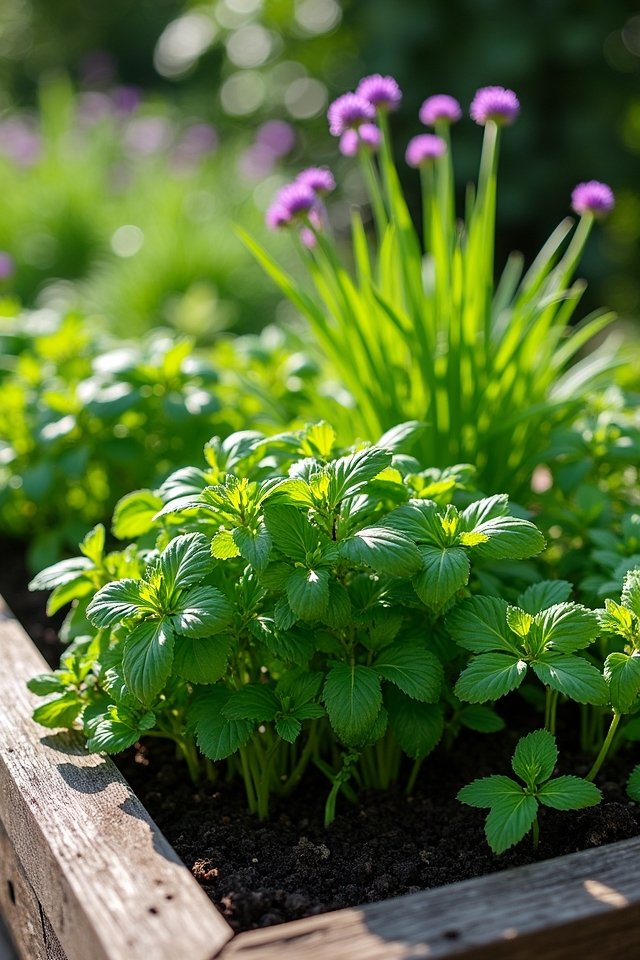
Imagine stepping into your garden and being greeted by a fragrant burst of fresh herbs, ready to elevate your culinary creations! Growing herbs in raised beds isn’t just practical; it’s a sensory delight! You can easily cultivate both culinary herbs for your kitchen and medicinal herbs for natural remedies. Here are five must-plant herbs that thrive in raised beds:
- Basil: Sweet and aromatic, perfect for pesto and salads.
- Mint: Invigorating and vigorous—just beware of its spread!
- Thyme: Earthy and versatile, ideal for roasting meats.
- Chamomile: A soothing medicinal herb for calming teas.
- Cilantro: Bold and zesty, a salsa superstar!
What could be more satisfying than snipping fresh herbs at dinner time? Get growing!
Companion Planting Techniques
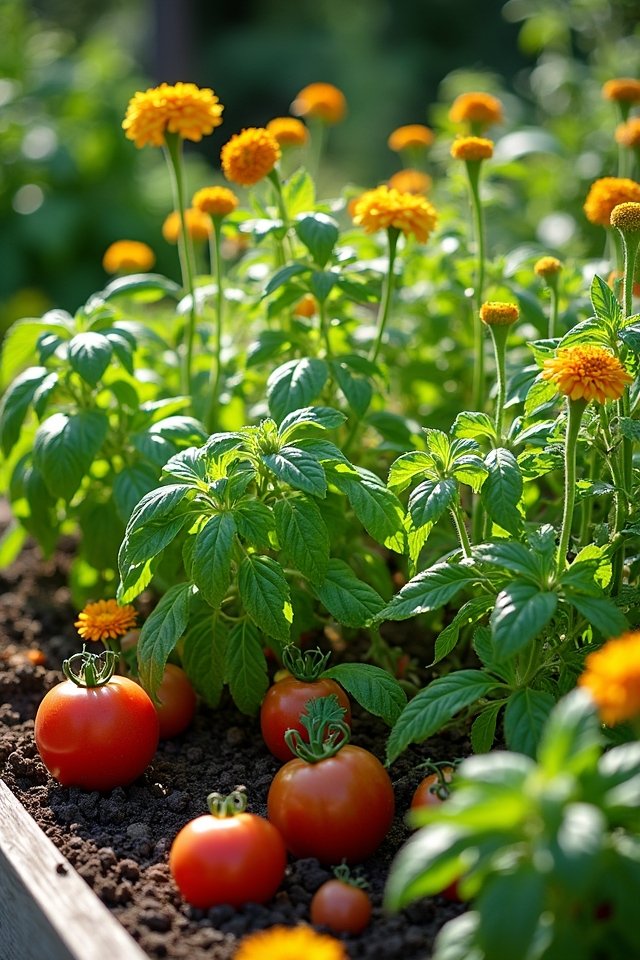
Companion planting isn’t just a gardening tactic; it’s like orchestrating a beautiful symphony in your raised beds! Imagine this: vibrant marigolds dancing alongside your tomatoes, warding off pests while attracting beneficial insects like ladybugs. This dynamic duo keeps your garden thriving! You can pair basil with peppers, as their flavors enhance each other while keeping pesky aphids at bay. It’s a win-win! By planting carrots near onions, you’re not just saving space, but also cleverly disguising the carrots’ scent from hungry flies. How cool is that? So, why not shake things up this season? Immerse yourself in companion planting and watch your garden become a bustling ecosystem, where plants support each other and nature takes the spotlight! 🌱
Soil Preparation Tips
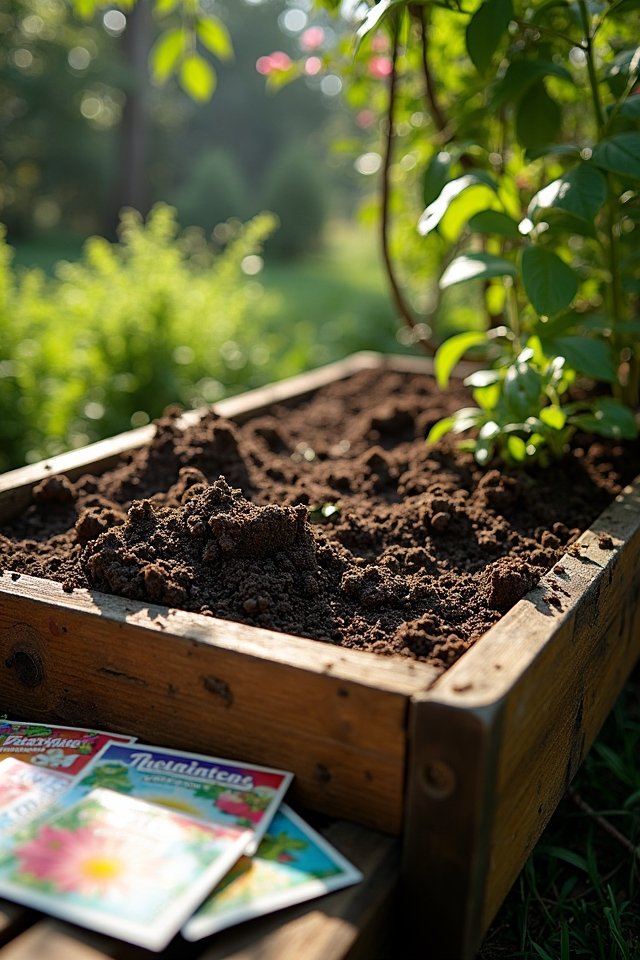
Getting your soil ready is like preparing a delicious recipe—you want all the right ingredients mixed just right! Start by testing your soil to find out its pH and nutrient levels. Knowing what’s in there helps you tailor your amendments perfectly. Here’s how to elevate your soil game:
- Use organic amendments like compost or aged manure for nutrient boosts!
- Blend in biochar for improved moisture retention and aeration!
- Add sand if your soil’s too heavy, promoting drainage and root growth!
- Sprinkle in some worm castings for that secret sauce of beneficial microbes!
- Finally, consider cover crops to enrich and protect your soil year-round!
With these steps, you’re set for a vibrant garden that truly flourishes! Ready to dig in? Let’s go!
Pest Management Strategies

While you may be dreaming of a vibrant garden, pesky pests can quickly turn that dream into a nightmare! Start by employing some smart pest identification techniques—think of it as a detective story for your plants. Spot those sneaky critters before they wreak havoc! Once you’ve pinpointed the troublemakers, release innovative organic pest solutions that work wonders. For instance, consider using neem oil or introducing ladybugs. These natural allies munch on aphids and other villains, keeping your garden happy! You might also plant marigolds to act as a protective shield. Remember, prevention is key; regular inspections and maintaining healthy soil can help bolster your plants against unwanted intruders. Your garden deserves a fighting chance, after all!
Crop Rotation Importance
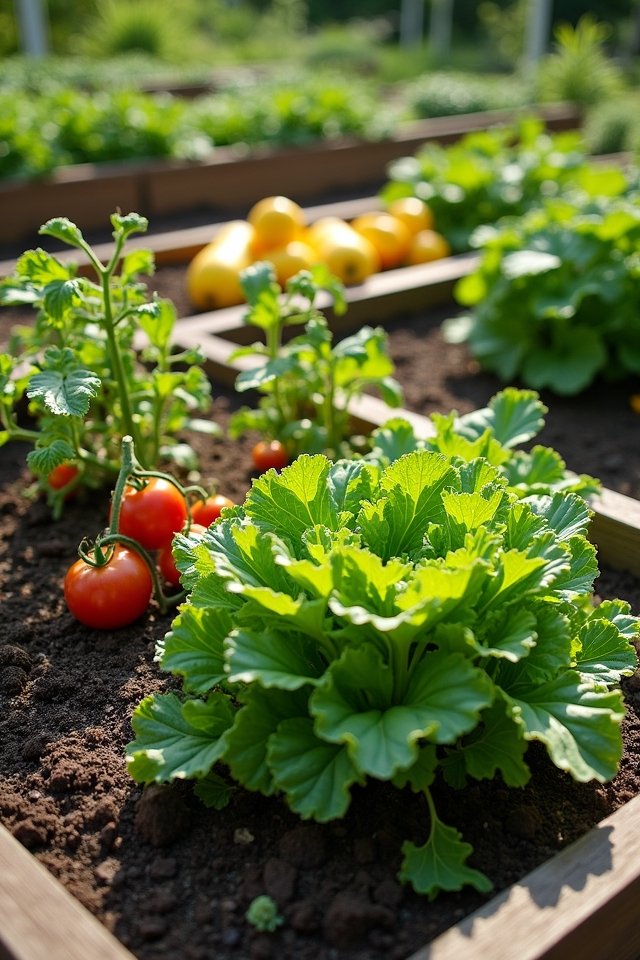
If you want to keep your garden thriving, embracing the charm of crop rotation is an absolute must! Not only does it boost soil fertility, but it also keeps your plants happy and healthy. Imagine a dance between crops, each taking turns in the spotlight!
Here’s why you’ll love crop rotation:
- Restores nutrients in the soil.
- Reduces pest and disease buildup.
- Promotes diverse plant growth.
- Enhances soil structure and biodiversity.
- Boosts your garden’s overall resilience.
Maintaining Soil Health
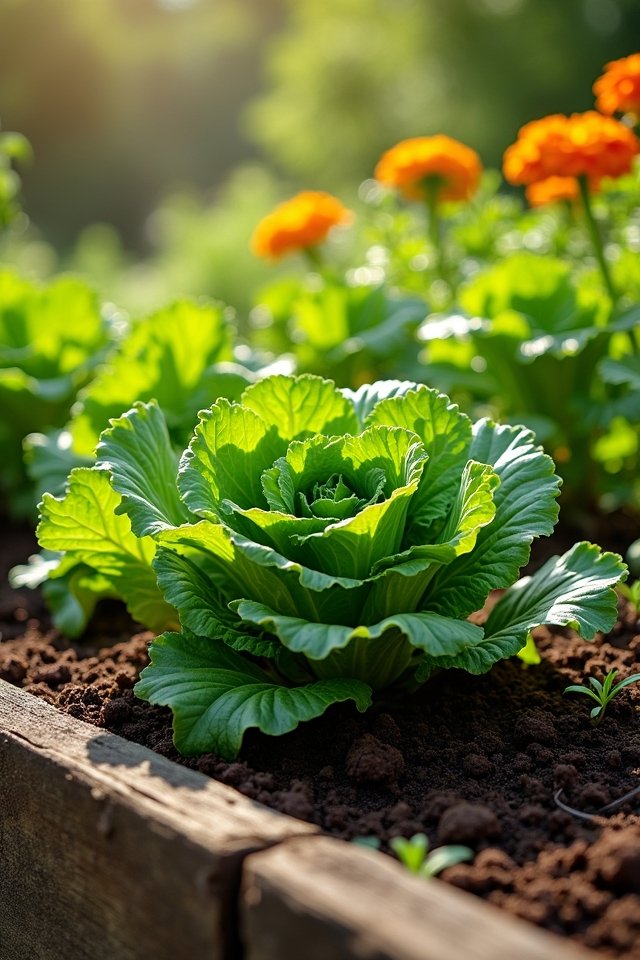
Healthy soil is the heart of a thriving garden! To keep your raised beds bursting with life, think about adding soil amendments like compost and aged manure. These magical mixtures work like potions, enriching your soil with essential nutrients. And don’t forget about organic fertilizers! They’re like a gourmet meal for your plants, providing the right balance of nourishment while being eco-friendly. You could sprinkle in some bone meal for phosphorus or kelp meal for trace minerals—what a treat!
Seasonal Care Tips for Raised Beds
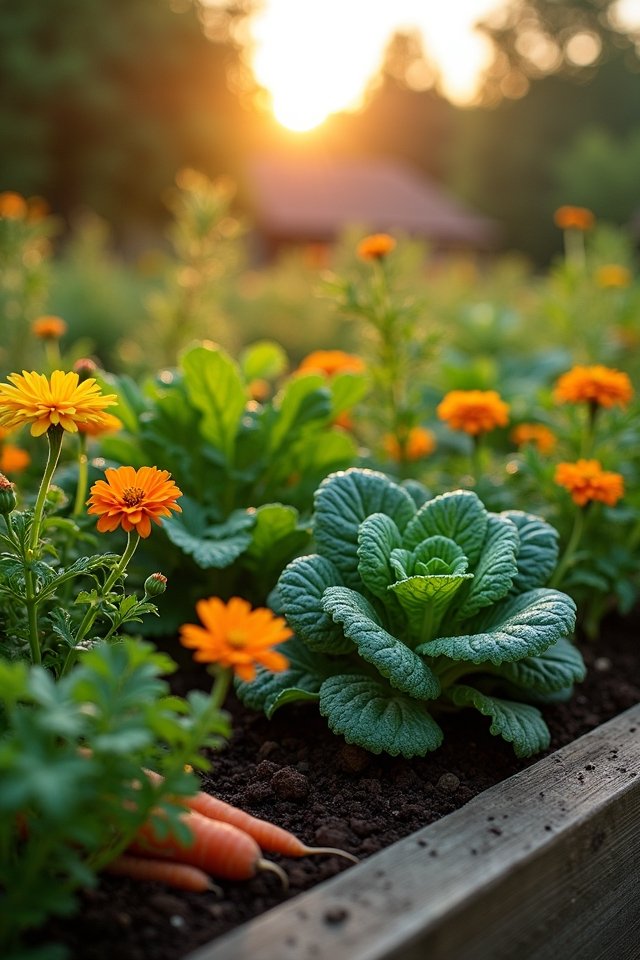
As you immerse yourself in the gardening season, don’t forget that seasonal care is the secret sauce to keeping your raised beds thriving! Embracing raised bed maintenance is essential to release your garden’s full potential. Here are some tips to keep your plants popping:
- Regularly check for pests – catch those sneaky critters early!
- Embrace seasonal pruning – trim back overgrown plants for healthier growth!
- Rotate crops – give your soil a refreshing change by changing what you plant!
- Add compost – boost your soil’s nutrients, nurturing plant happiness!
- Water wisely – consider morning irrigation to prevent evaporation and guarantee hydration!
Get ready to watch your garden flourish! Remember, with a little love, your raised beds will spark joy all season long!
Frequently Asked Questions
How Do I Choose the Best Location for My Raised Beds?
Choosing the perfect spot for your raised beds is like finding the best seat at a concert! You want maximum sunlight exposure, so pick a location that basks in sunlight for at least six hours daily. Also, guarantee excellent soil drainage; nobody wants soggy roots! Consider near a water source for easy watering, and keep away from pesky tree roots. Happy gardening! Your plants will thank you for these thoughtful choices.
Can I Plant Flowers in My Vegetable Raised Beds?
Absolutely, you can plant flowers in your vegetable raised beds! Think of them as your garden’s cheerleaders. Flowers like marigolds, for instance, boost flower compatibility and act as natural pest deterrents. Isn’t that brilliant? By practicing companion planting, you create a vibrant ecosystem that enhances flavors in your veggies. Just imagine bright blooms surrounded by greens, swaying in the breeze! So, why not mix a little color and function in your garden?
What Materials Are Best for Building Raised Beds?
When it comes to building raised beds, you’ve got some fantastic options! Cedar wood types are like the superheroes of gardening—naturally rot-resistant and gorgeous! Pair that with a breathable bed liner to keep weeds at bay, and you’re golden! Don’t underestimate the charm of a sturdy pine either, it’s budget-friendly! Just remember, your raised bed is like your garden’s cozy little home—make it comfortable, and those veggies will thrive!
How Deep Should My Raised Bed Soil Be?
So, how deep should your raised bed soil be? Aim for at least 12 inches, but 18 inches gives your plants room to thrive! Think of it as a cozy, nourishing spa for roots. A rich soil composition keeps everything happy, while good drainage solutions prevent soggy surprises. You wouldn’t want your plants to drown, right? So, dig deep and watch your garden flourish! Your greens will thank you with vibrant growth!
When Should I Start Seeds Indoors for the Season?
You might want to start your seed starting adventure indoors about six to eight weeks before your last frost date. Picture your cozy indoor gardening space filled with tiny green soldiers ready to emerge! Tomatoes, peppers, and basil are perfect candidates. Just imagine the rich aroma wafting through your home! Keep an eye on moisture and light levels—your future harvest’s counting on it. Ready to release some green magic? Let’s grow!
